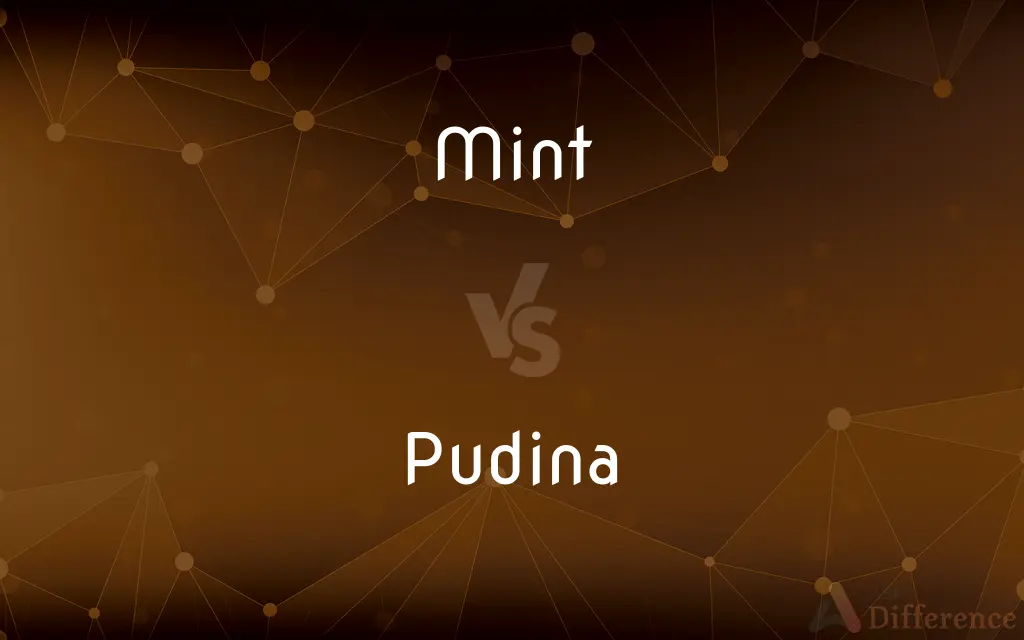Mint vs. Pudina — What's the Difference?
By Tayyaba Rehman & Maham Liaqat — Updated on April 23, 2024
Mint refers to a family of aromatic plants, while pudina is the Hindi term specifically for spearmint, a popular variety of mint.

Difference Between Mint and Pudina
Table of Contents
ADVERTISEMENT
Key Differences
Mint encompasses a wide range of species within the genus Mentha, known for their aromatic leaves. Pudina, on the other hand, specifically refers to spearmint in Hindi and is used extensively in Indian cuisine.
Mint varieties include peppermint, spearmint, and watermint, each with distinctive flavors and uses. Pudina, or spearmint, features a milder flavor and aroma compared to peppermint, making it preferred for culinary uses in India.
While mint leaves are used globally in everything from toothpaste to teas, pudina is particularly noted for its role in traditional Indian remedies and recipes such as chutneys and raitas.
In gardening, mint is appreciated for its hardiness and ease of growth, spreading quickly in suitable conditions. Pudina also shares these growth characteristics but is often grown in pots in Indian homes to manage its spread and for easy access for cooking.
Mint is utilized in Western medicine for its digestive benefits and as a natural remedy for nausea and headaches. Pudina shares these medicinal properties and is often used in Ayurvedic treatments for similar purposes.
ADVERTISEMENT
Comparison Chart
Definition
A genus of plants known for aromatic leaves.
Hindi term for spearmint, used in Indian cuisine.
Varieties
Includes peppermint, spearmint, watermint, etc.
Generally refers only to spearmint.
Flavor
Ranges from strong (peppermint) to mild (spearmint).
Milder, suited for savory dishes and drinks.
Primary Uses
Culinary, medicinal, cosmetic.
Predominantly culinary and medicinal in India.
Growth Characteristics
Fast-spreading, can be invasive.
Often grown in containers in India to control spread.
Compare with Definitions
Mint
Aromatic herb known for its cool, refreshing flavor.
Mint is often added to iced beverages for a refreshing twist.
Pudina
Features in drinks like mint tea and coolers.
Pudina is used to make refreshing mint tea in India.
Mint
Plant used medicinally to aid digestion and relieve headaches.
Mint tea is a popular remedy for upset stomachs.
Pudina
Grown in pots in India for culinary and medicinal use.
Many Indian homes have a pot of pudina on their balcony.
Mint
Hardy perennial that thrives in many gardens.
Mint plants can easily take over garden spaces if not contained.
Pudina
Spearmint in Hindi, commonly used in Indian cuisine.
Pudina chutney is a staple in many Indian households.
Mint
Culinary herb used in sauces, teas, and cocktails.
Mint is essential in making a classic mojito cocktail.
Pudina
Used in traditional Ayurvedic remedies.
Pudina is often recommended for its cooling properties in Ayurveda.
Mint
Common ingredient in dental hygiene products.
Many toothpastes use mint for its flavor and breath-freshening properties.
Pudina
Ingredient in raitas and salads for a fresh flavor.
Pudina adds a burst of freshness to yogurt-based raitas.
Mint
A place where the coins of a country are manufactured by authority of the government.
Pudina
A form of mint found in parts of India and Pakistan and used there in cooking food & preparation of tea, Mentha arvensis.
Mint
A place or source of manufacture or invention.
Mint
An abundant amount, especially of money.
Mint
A member of the mint family.
Mint
Any of various rhizomatous plants of the genus Mentha of the mint family, characteristically having nearly regular white or purple flowers. Some species are cultivated for their aromatic oil and foliage.
Mint
The leaves of some of these plants, used as a seasoning.
Mint
Any of various similar or related plants, such as the stone mint.
Mint
A candy flavored with natural or artificial mint flavoring.
Mint
To produce (money) by stamping metal; coin.
Mint
To invent or fabricate
A phrase that was minted for one occasion.
Mint
Undamaged as if freshly minted
The painting was in mint condition.
Mint
A building or institution where money (originally, only coins) is produced under government licence.
Mint
(informal) A vast sum of money; (by extension) a large amount of something.
That house is worth a mint.
It must have cost a mint to produce!
To make a mint
Mint
(figuratively) Any place regarded as a source of unlimited supply; the supply itself.
Mint
Any plant in the genus Mentha in the family Lamiaceae, typically aromatic with square stems.
Mint
The flavouring of the plant, either a sweet, a jelly or sauce.
Mint
Any plant in the mint family, Lamiaceae.
Mint
A green colour, like that of mint.
Mint
A mint-flavored candy, often eaten to sweeten the smell of the breath.
Mint
Intent, purpose; an attempt, try; effort, endeavor.
Mint
(transitive) To reproduce (coins), usually en masse, under licence.
Mint
To invent; to forge; to fabricate; to fashion.
Mint
To create a crypto token.
Mint
To try, attempt; take aim.
Mint
To try, attempt, endeavor; to take aim at; to try to hit; to purpose.
Mint
To hint; suggest; insinuate.
Mint
(with condition) Like new.
In mint condition
Mint
In near-perfect condition; uncirculated.
Mint
(philately) Unused with original gum; as issued originally.
Mint
Very good.
Mint
Attractive; beautiful; handsome.
Mint
Of a green colour, like that of the mint plant.
Mint
The name of several aromatic labiate plants, mostly of the genus Mentha, yielding odoriferous essential oils by distillation. See Mentha.
Mint
A place where money is coined by public authority.
Mint
Any place regarded as a source of unlimited supply; the supply itself.
A mint of phrases in his brain.
Mint
A large quantity of money; as, to make a mint in stock trading.
Mint
To make by stamping, as money; to coin; to make and stamp into money.
Mint
To invent; to forge; to fabricate; to fashion.
Titles . . . of such natures as may be easily minted.
Mint
Like new; in brand-new condition; unworn, as a coin recently made at a mint{1}; as, he had a '53 Cadillac in mint condition.
Mint
Uncirculated; in the same condition as when it was freshly coined at the mint{1}.
Mint
(often followed by `of') a large number or amount or extent;
A batch of letters
A deal of trouble
A lot of money
He made a mint on the stock market
It must have cost plenty
Mint
Any north temperate plant of the genus Mentha with aromatic leaves and small mauve flowers
Mint
The leaves of a mint plant used fresh or candied
Mint
A candy that is flavored with a mint oil
Mint
A plant where money is coined by authority of the government
Mint
Form by stamping, punching, or printing;
Strike coins
Strike a medal
Mint
As if new;
In mint condition
Common Curiosities
How can I grow pudina at home?
Pudina can be easily grown in pots with ample sunlight and regular watering, much like other mints.
Can pudina be used the same way as other mints?
Yes, pudina can be used similarly to other mint varieties, though it is particularly favored in Indian dishes for its milder flavor.
Is there a taste difference between mint and pudina?
Yes, pudina (spearmint) tends to have a milder, sweeter taste compared to the stronger, more intense flavor of peppermint.
What are common uses of mint in cooking?
Mint is used in a variety of dishes, from lamb in Western cuisines to mint chutneys and mojitos in beverages. It adds a fresh, cool flavor to both savory and sweet dishes.
Are there different health benefits between mint and pudina?
Both share similar health benefits, such as aiding digestion and soothing stomach issues, though specific benefits can vary slightly among different mint species.
What is the main difference between mint and pudina?
Mint refers to the entire genus of Mentha plants, while pudina specifically refers to spearmint, primarily in the context of Indian cuisine.
How do the medicinal uses of mint and pudina differ?
While both are used for similar medicinal purposes like aiding digestion and soothing headaches, pudina is additionally used in Ayurvedic practices for its cooling properties, particularly in treating inflammations and throat infections.
Why is pudina particularly popular in Indian cuisine?
Pudina is favored in Indian cuisine for its milder flavor which complements the rich spices commonly used in the cuisine, enhancing dishes without overpowering them.
What should I consider when planting mint or pudina in a garden?
Both mint and pudina are invasive and can quickly take over garden areas. It's advisable to plant them in contained spaces or pots to control their spread.
Can mint and pudina be used interchangeably in recipes?
While they can be substituted for each other in many recipes, the flavor intensity differs. Pudina, being milder, is better for delicate dishes, whereas other mints like peppermint might be too overpowering for the same recipes.
Share Your Discovery

Previous Comparison
Stitch vs. Suture
Next Comparison
Sophisticated vs. ElegantAuthor Spotlight
Written by
Tayyaba RehmanTayyaba Rehman is a distinguished writer, currently serving as a primary contributor to askdifference.com. As a researcher in semantics and etymology, Tayyaba's passion for the complexity of languages and their distinctions has found a perfect home on the platform. Tayyaba delves into the intricacies of language, distinguishing between commonly confused words and phrases, thereby providing clarity for readers worldwide.
Co-written by
Maham Liaqat













































